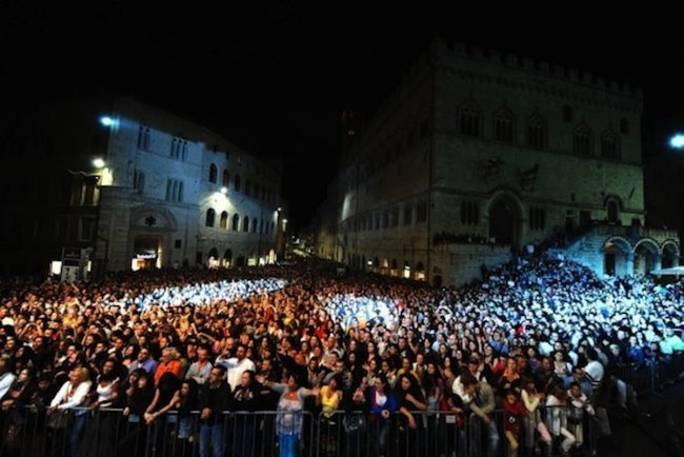


Umbria. A land of splendors that span centuries. Or millennia. Starting with the ancient Etruscans who inhabited central Italy long before the Romans. Visitors who come here breathe in a mysterious, age-old air that still permeates today’s way of life.
The same air wafts around “Umbria Jazz [2]”, the most important Italian jazz festival inaugurated in 1973. The festival’s two programs— summer in Perugia [3] and winter in Orvieto—gather the best artists jazz has to offer in the most magical corners of Italy. Magical surroundings accompany magical shows.
To learn more about the festival, we met with Umbria Jazz’s founder and artistic director, Carlo Pagnotta [4], during one of his frequent visits to the U.S. Forty years ago Pagnotta was a young successful clothing salesman in Perugia whose passion for jazz led him to frequent the major European festivals.
Even back then he was dreaming of Umbria Jazz. He really wanted a festival in his hometown, and he realized his dream with the help of two forward-thinking council members from the Region of Umbria.
“I always wanted the best for my region. This is what my father taught me. He owned one of the best restaurants in the 1950s, one of the first to receive Michelin stars.” Pagnotta wouldn’t settle for second best for music either. Or at least for jazz, the music he loved. Thanks to his vision, Umbria has now become the jazz capital of Europe. “In Italy in the ’70s, there was only one important festival, the San Remo festival of the song [5]. There were several jazz clubs but they didn’t communicate with one another. So Umbria really stuck its neck out.”
The festival held its first concert on August 23, 1973. It was the beginning of an adventure that would only be interrupted once, during the politically volatile years between 1978 and 1982. They were the so-called “Years of Lead” and major artists like Chet Baker [6] and Stan Getz [7] were jeered at for being white and middle class. “But we didn’t want a festival of protestors, we wanted a festival for aficionados,” recalls Pagnotta.
In 1982 the Festival took off again and in 1985 the Region set up the Umbria Jazz Foundation to guarantee public financing for the festival. “The results [of that support] are in. Today Umbria is known for Saint Francis [8] and for Umbria Jazz.”
Pairing Sting with Gil Evans
The founder emotionally recalls, “When we first got going, the giants of jazz were still alive. Art Blakey and Dizzy Gillespie [9] were still making the rounds. Extraordinary times. Then came what spawned the so-called ‘contamination’ era, when we paired Sting with the Gil Evans orchestra. It was a unique concert. The beginning of a major change. It’s useless to deny the fact that jazz music isn’t for the masses, it’s for niches. The Sting concert brought in 40,000 people and made Umbria Jazz more prominent on the world map.”
It’s almost impossible to describe the atmosphere surrounding Umbria Jazz. The sensation is a clash of past and present amid the roar of music. “Scores of journalists from around the world have been sent here,” says Pagnotta with a flush of pride “and none of them failed to notice this. The difference between Umbria Jazz and other festivals is that ours is held in places imbued with history. That magic can’t be found elsewhere and you have to come to understand what I mean.” Not for nothing have countless hotels and restaurants sprung up in direct proportion to the festival’s fame.
Italian jazz
But how does Umbria Jazz put together its program? “First of all, we work with the International Jazz Festival. We meet with promoters four times a year. It takes a lot of work and experience, including fund-raising. Public financing is always on the wane, politicians continue to think that culture doesn’t put food on the table. Besides, when Italy does invest in music it still only invests in opera and classical music, not jazz.”
Fortunately, the Region of Umbria is different: they have invested 600,000 Euros this year for the Perugia and Orvieto programs. No other region has done that. This allowed Umbria Jazz to succeed and show the world that there’s such a thing as Italian jazz. “The Newport Festival [10] celebrated its 60th anniversary last summer. And for the first time an Italian played the festival, Stefano Bollani, who came straight out of Umbria Jazz.”
Italian jazz is second only to American jazz
“Italians have played a really important role in the creation of jazz music. Nevertheless, still twenty years ago you could count the number of Italians in the field on one hand. Enrico Rava [11], maybe, or Giovanni Tommaso [12]. Today there are tons of great young Italian jazz musicians who are in demand. You could say that Italian jazz is second only to American jazz.”
Naturally, the relationship between the US and Umbria Jazz is very intense. Over the years Umbria Jazz has brought many Italian musicians to American cities. “We began in 1983 in North Carolina, eventually making our way up to Boston and New York more recently. At first the Italians were playing smaller venues on Mondays, the ‘day off.’ Today they play Tuesdays through Sundays in the most important venues.”
The Umbria Jazz Foundation also has ties to American universities, like the Berklee College of Music in Boston [13]. “This year we’re celebrating our 30th year of collaborating together. For two weeks a year 250 American and international students come to Perugia.”
Lastly, we have to ask: Does Pagnotta have another dream tucked under his pillow?
“People have long talked about the first time jazz came to Carnegie Hall. It would be great to see an Italian jazz musician play there.”
Source URL: http://440468.6bgr9ubv.asia/magazine/focus/life-people/article/meet-carlo-pagnotta-artistic-director-umbria-jazz-festival
Links
[1] http://440468.6bgr9ubv.asia/files/umbriajazzfestival1417558966jpg
[2] http://www.umbriajazz.com/
[3] http://en.wikipedia.org/wiki/Umbria
[4] http://www.umbriajazz.com/pagine/fondazione-000
[5] http://en.wikipedia.org/wiki/Sanremo_Music_Festival
[6] http://en.wikipedia.org/wiki/Chet_Baker
[7] http://www.stangetz.net/
[8] http://en.wikipedia.org/wiki/Francis_of_Assisi
[9] http://www.dizzygillespie.com/
[10] http://www.newportfolk.org/
[11] http://www.enricorava.com/
[12] http://it.wikipedia.org/wiki/Giovanni_Tommaso
[13] http://www.berklee.edu/